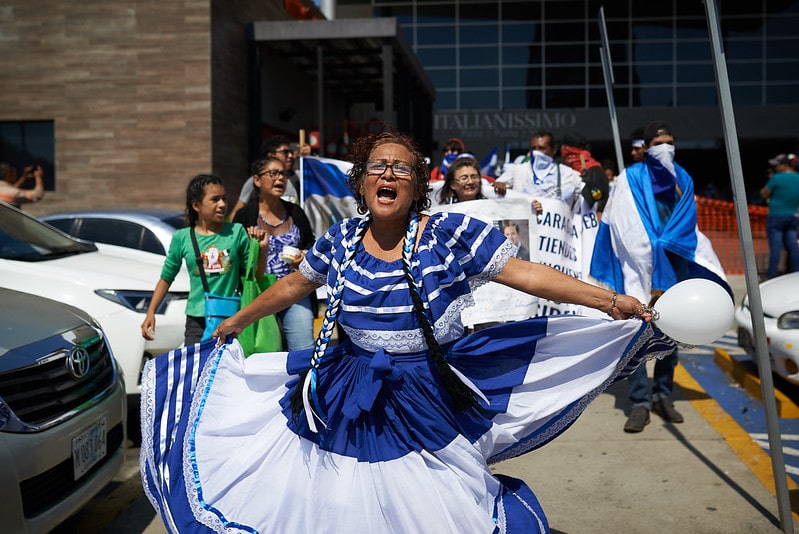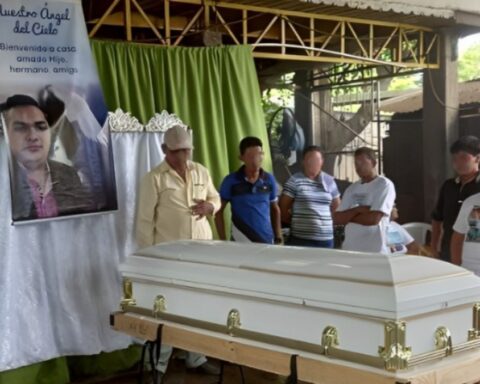Three years of constant siege, persecution and threats, added to arbitrary arrests and beatings of people related to the regime of Daniel Ortega and Rosario Murillo, motivated Flor de María Ramírez, known since the 2018 citizen protests as “the lady of the huipil”, to flee Nicaragua to “save” his life.
Ramírez, 66, left the country on April 16, accompanied by one of her children. The opponent left her home, in Managua, at around 2:00 am, because the policemen who stationed themselves outside her house every day arrived at 5:00 am
“We left on Gloria Saturday. We left before the police arrived, and we made sure there were no civilians, because they also sent out surveillance. We rushed out, grabbed a taxi and said goodbye, in the midst of fear and tears, to our home,” Ramírez told CONFIDENTIAL.
The “lady in the huipil” left the country through a blind spot in the border area of El Guasaule, in Chinandega, between Nicaragua and Honduras, with the help of “a friend,” who asked her for ten dollars to take her along a path that is little guarded by the immigration authorities of both countries.
The citizen highlighted that, for the entire trip, she had 900 dollars that she obtained from the sale of furniture, appliances and some sewing machines that she had in her business in Nicaragua.
He continued to cross Honduran territory by transferring on more than three buses, and on the morning of April 17 he was already in Guatemalan territory, which he was able to reach after paying $20 to a woman who, seeing that they could not afford the charged by the “coyotes” in the area, offered to cross them through a little guarded point.
Detained in Guatemala
“Already being in Guatemala we paid 200 dollars for a taxi that took us to the bus station that went to the capital. They pay bribes to the Immigration agents that they come across, and that’s how we got to take the bus that was going to take us to the capital of that country, but some policemen stopped the bus, asked us for papers, and since we didn’t have permission to transit, they stopped us that same afternoon,” Ramírez lamented.
He stated that the policemen who arrested them were “hostile” and, although there were no blows, they “mistreated” them.
“They took us to a station that was near the place and there I begged them to let us go, that we were fleeing from Nicaragua because the dictatorship was persecuting us, but they made fun of us. They told us that they were going to take us to a shelter and what they did was return us to the Honduran border. I complained about what they were doing and they threatened me saying that if I kept complaining they would send me to Nicaragua”, he denounced.
“It was hard. I cried at that moment, because it seemed to me that he was with the Nicaraguan guard. The only thing those Guatemalan police officers did not do was hit me, but yell at me and humiliate me, they did,” he added.
Ramírez and his son, despite being returned to the Honduran border, did not give up on continuing on their way to the United States. The woman stated that, after crying and praying for about an hour sitting on a sidewalk next to the border post, a young man approached her to offer to cross back into Honduras, asking her to give him what she could.
“A boy approached me and said: ‘Mother, do you want to cross? Don’t cry, if you trust me, I’ll take you’. We went with him, he managed to cross us and that same night he was back in Guatemala. We only paid him 50 quetzales —about 6.50 dollars— which in the end was what he asked us for, although at the beginning he said that we should give him what we could, ”he detailed.
In this second attempt, Ramírez decided to take another route so as not to be detained again by the Guatemalan authorities. She was transported in up to five minibuses, which took alternate routes to the main roads, to be able to reach the capital, and then to the border area between Guatemala and Mexico.
“I entered Mexico through the Tapachula area. We found a person who crossed us for 70 dollars, because they charge much more there, ”he commented.
More than a month in Mexico
It took Ramírez more than 30 days to reach the border area between Mexico and the United States. He spent a month in the state of Chiapas, on the border with Guatemala, to apply for a humanitarian visa and travel “more calmly” through Mexican territory.
“We rented an apartment for a month, it was 120 dollars, and we began to process the humanitarian visa. It was a long process because we arrived on April 20 and they gave it to us until May 25, ”she indicated.
Already with the humanitarian visa, Ramírez resumed the journey to the United States. On May 26, he and his son took a direct bus to Mexico City and then, tirelessly, another to Acuña, a border area with the United States, where they arrived the next day.
Ramírez crossed the Rio Grande on the morning of May 28. He assured that it was a “very difficult” moment and before entering those waters “I entrusted myself to God.”

“Migration caught me around nine in the morning, it was some gringos who were in a minibus, they ran into us near some cornfields, already in North American territory, they asked me something in English and I told them in Spanish: ‘we are Nicaraguans and we come fleeing from Nicaragua. He didn’t ask us anything else, he opened the minibus for us and took us to a place where they took the migrants they were grabbing, she said.
The “lady in the huipil” was only held for three days by the United States Immigration authorities, in Del Río, Texas. “My release, from the detention center, was like a Mother’s Day gift, because on May 30 itself they told me to enlist, that I’m leaving,” said Ramírez.
She explained that before leaving they asked her for an address where to locate her and she gave one that a friend lent her. She was given a cell phone with which they monitor her every week, through photos and geolocation, and they gave her five days to move to the place where she would be staying while she faces the asylum application process.
Ramírez assured that he is now waiting for a positive result for his application and for a job opportunity to materialize, because, although he loves Nicaragua, “I cannot return, because my life is in danger there, the dictatorship would no longer let me live in peace.”
Persecution in Nicaragua
“They came to harass me every day, they threatened me and my family. They said that if they found me on the street they were going to arrest me or disappear. I could no longer work, no clients came to my sewing workshop due to the siegeand if I went out looking for something they followed me or investigated me to find out where I was, I couldn’t go out because the police were behind me, I got on a bus, then in a taxi, that was my life, walking, running, and I no longer I wanted to live like this,” Ramírez said as her voice cracked.
Doña Flor, as those who know her affectionately call her, began her participation in the protests on April 20, 2018. In August of that same year, she decided to support the marches wearing a blue and white huipil, in honor of a young woman who was arrested. in that month for dancing folklore in a sit-in that took place on the outskirts of the Central American University (UCA).
The “lady in the huipil” was arrested for the first time by the Ortega regime Police in September 2018. On that occasion, a police officer yelled at her: “If you don’t shut up, I’m going to shoot you and I’m going to make you disappear,” while they took her to the facilities of the Directorate of Judicial Assistance, known as El Chipote, where they photographed her and threatened her. to stop protesting.
The Inter-American Commission on Human Rights (IACHR) in August 2021, granted precautionary measures in favor of Ramírez, warning that his physical integrity and life were in “extreme seriousness and risk”, due to the “constant siege, threats, persecution and aggressions physical” that he suffered.








